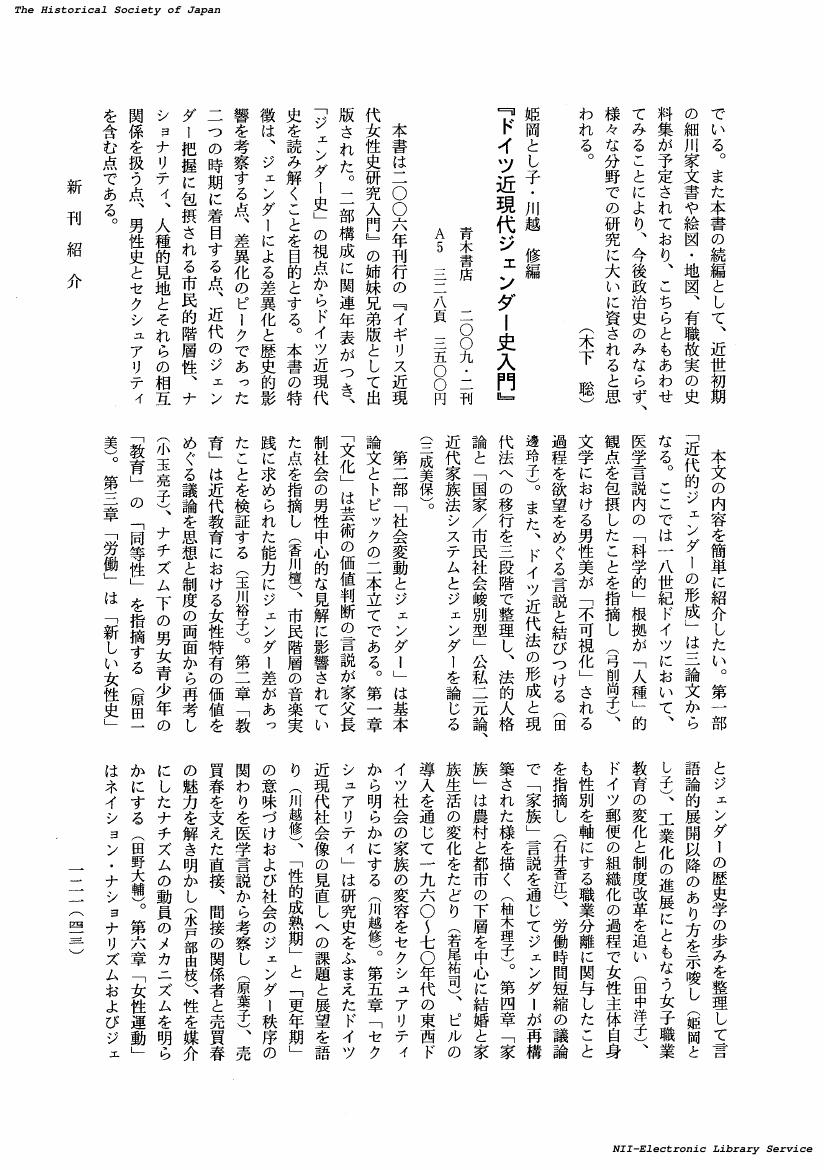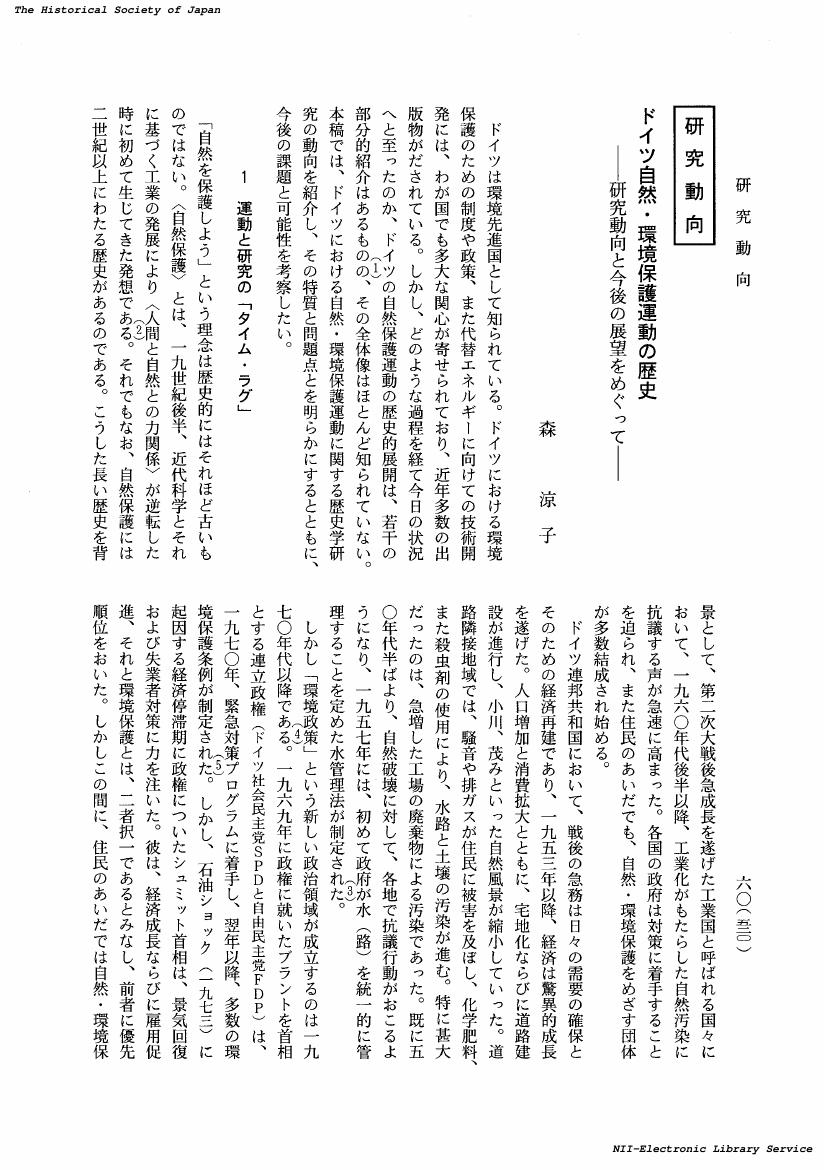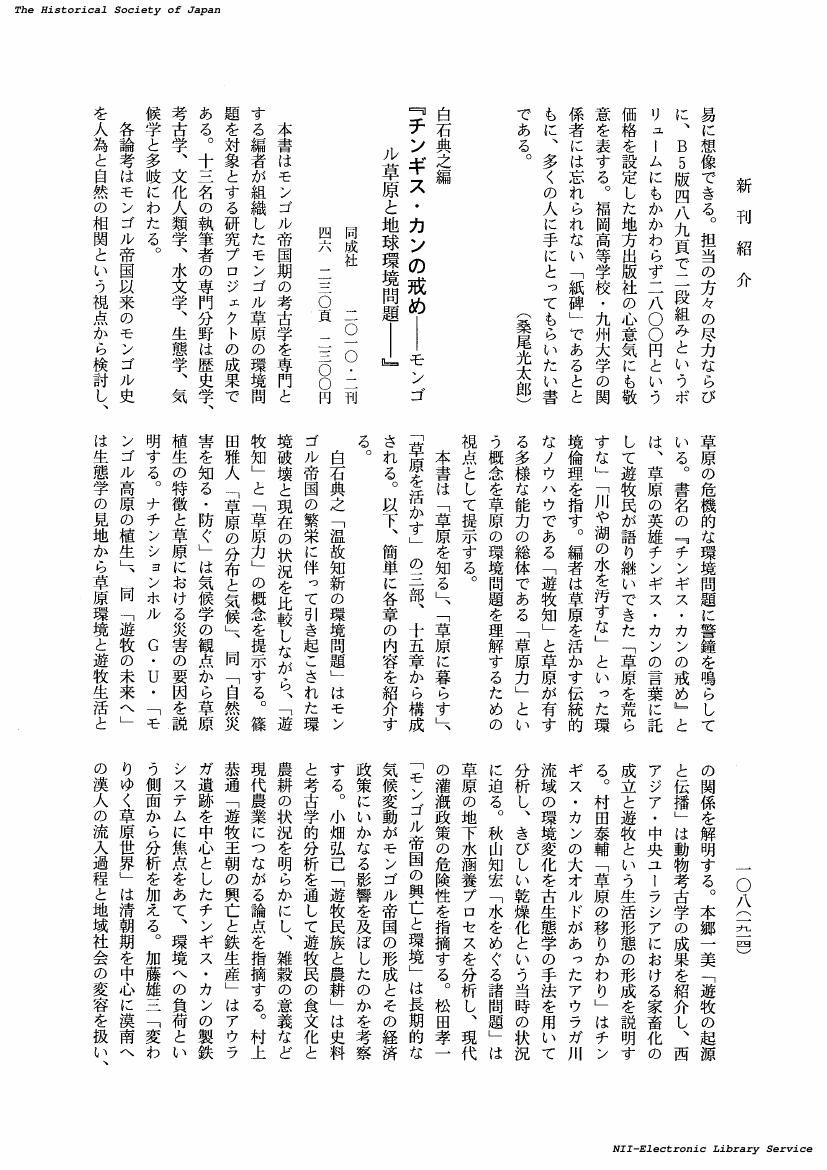1 0 0 0 実践的な高等学校家庭科「染色」教材開発のための先行論文の検討
- 著者
- 駒津 順子 小松 恵美子 森田 みゆき
- 出版者
- 日本家庭科教育学会
- 雑誌
- 日本家庭科教育学会大会・例会・セミナー研究発表要旨集
- 巻号頁・発行日
- vol.51, pp.76, 2008
<B><目的></B> 高等学校家庭科で実施する「染色」教材の開発研究を行ってきた。高等学校家庭科において「染色」の辿ってきた歴史を知るために、高等学校学習指導要領・教科書等における「染色」取り扱い科目及び領域の変遷について調査したところ、家庭科における「染色」は、「更正染」「手芸染色」「生活文化の伝承」の順に変遷し位置づけられていることがわかった。今の時代を反映した「染色」教材を開発するための視点を検討した結果、高等学校家庭科における「染色」の授業は、「生活スキルの向上により生徒に自信を持たせ、自己理解を深めさせることができる」と考えられた。今回は、実践的な教材開発のために、「染色」教材や「染色」研究についての論文検索を行い、先行研究を抽出して内容を比較検討した。それらを元に教材化のための予備実験を行った。<BR> <B><方法></B> 論文検索は学会誌5誌と商業誌7誌を対象とした。学会誌は、繊維学会誌、日本家政学会誌、日本家庭科教育学会誌、日本蚕糸学会誌、化学と教育、であった。また商業誌は、染色研究、染料と薬品、染色工業、色材、月刊染織α、京染と精練染色、考古学と自然科学、であった。論文検索には、国立情報学研究所(NII)のポータルサイトであるCiNii(NII論文情報ナビゲータ)を使用した。論文は発表年が2005年までのものを対象とした。論文の抽出および分類は13のキーワード(染色法、色素の合成、分解、洗浄、環境、廃液、堅牢度、拡散、天然染料、染色教材、染色領域、顔料、その他)を設定し、論文タイトルから読み取り該当するものを抽出した。なお、「繊維学会誌」と「日本家政学会誌」の2誌に関しては、CiNii掲載以前の論文についても検索対象とした。<BR> <B><結果></B> 学会誌の検索論文総数は18,087件であり、染色教材に関するものは日本家庭科教育学会誌が1件、化学と教育が43件であった。一方、商業誌の検索論文総数は4,901件であり、染色教材に関するものは月刊染織αが8件であった。日本家庭科教育学会誌から抽出された論文は生野ら<SUP>(1)</SUP>によるものであった(以下論文1とする)。この他に、大学紀要等で発表されている論文2<SUP>(2)</SUP>、論文3<SUP>(3)</SUP>、論文4<SUP>(4)</SUP>を加えた4件の論文を検討対象とした。論文1は玉葱、紅茶、紅花、藍の染色条件を検討し堅牢性も調べた上で標本を作成しており、実践的な教材を検討するには最も参考になると考えられた。論文1の染色材料の中で手に入りやすいものは玉葱と紅茶であった。教材としては媒染剤による色相の変化が大きい方が望ましく、また被服だけでなく家庭科の様々な科目で実践が想定できることから、玉葱を染色材料に選び、論文1の実験条件をもとに予備実験を行った。実験はすべて水道水を使用して行った。のり無し白布を試料布として、同一染液で布を換えて2回染色を行い、色の濃さを比較した結果、目視では1回目染液染色布と2回目染液染色布の差は見られなかった。媒染剤は5種類を検討した。鉄明礬と硫酸第一鉄アンモニウムは暗緑色、カリウム明礬は山吹色、塩化カリウムとリン酸水素二カリウム、及び未媒染は薄茶色となった。<BR> <B><引用文献></B>(1)染色教材への天然植物染料の適用-主として玉葱・紅茶の場合-、生野晴美、堀内かおる、岩崎芳枝、日本家庭科教育学会誌、34、31-36(1990)、(2)地域素材を用いた染色教材の開発-さくらの葉を用いた場合-、日景弥生、三國咲子、弘前大学教育学部紀要、80、71-78(1998)、(3)小学校家庭科と関連させた「総合的な学習の時間」の構築-草木染めの教材化-、後藤景子、橘高純子、京都教育大学紀要、107、115-122(2005)、(4)天然藍の染色教材への適用、浦野栄子、萩原應至、信州大学教育学部附属教育実践研究指導センター紀要、7、181-188(1999)
1 0 0 0 OA モンゴル合戦の恩賞配分と充行状
- 著者
- 高 銀美
- 出版者
- 公益財団法人 史学会
- 雑誌
- 史学雑誌 (ISSN:00182478)
- 巻号頁・発行日
- vol.121, no.1, pp.43-67, 2012-01-20 (Released:2017-12-01)
The Mongols invaded Japan in 1274 and 1281, both times unsuccessfully. With regard to the subject of rewards distributed among warriors who fought against the invasions, the research to date has been based on analyzing documents (ateokonaijo 充行状) certifying that payments were made to individual warriors. Consequently, we generally know when a reward was given to whom; however, further study is required in order to discover out whether rewards were paid to all the warriors who fought, and if so, when the payment process was completed. This is the reason behind the possibility that the payment process may not have been completely over immediately after the invasions. This article attempts to clarify when the distribution was completed, based on the documents left by warriors who raised objections after being excluded from payment. It also traces changes that occurred in the form of the ateokonaijo that were issued after the second Mongol invasion and their significance. After the first Mongol invasion of 1274, investigations were conducted to find those warriors who showed great valor and was completed in the 12th month of the same year. The rewards granted as a result were paid no later than the 3rd month of the year after next. In the case of the second invasion of 1281, a similar investigation was carried out from 1281 to 1286, and the warriors who were acknowledged for their service received rewards over four occasions between 1286 and 1290. However, a number of warriors who were not so acknowledged filed a petition for reinvestigation, and a review was held. Consequently, the Kamakura Shogunate made a promise to provide another round of rewards to the newly acknowledged recipients. It can be confirmed that the promise was fulfilled later on. In other words, the reward process for military service in the defensive action against the Mongols was in fact completed, and the Kamakura Shogunate did not abandon its basic principle of providing compensation to its vassals who fought. In addition, on the basis of changes that took place in the form of ateokonaijo, the Mongol invasions seem to have served as an opportunity for the HOTO clan of regents who controlled the Kamakura Shogunate to strengthen its absolute authority within the institution. The fact that different forms of ateokonaijo were issued in order to distinguish vassals charged with the military policing of provinces (shugo 守護) and other vassals indicates that Shogunate vassals were beginning to be treated unequally.
- 著者
- 酒井 徹也 笹田 真滋 徐 千恵子 杉原 快 石岡 宏太 高橋 左枝子 中村 守男
- 出版者
- 特定非営利活動法人 日本呼吸器内視鏡学会
- 雑誌
- 気管支学 (ISSN:02872137)
- 巻号頁・発行日
- vol.40, no.5, pp.417-422, 2018-09-25 (Released:2018-10-13)
- 参考文献数
- 13
背景.気管支鏡検査は被験者の苦痛の強い検査であり,苦痛軽減のため鎮静薬などが考慮されるべきである.当院では気管支鏡検査時の苦痛軽減を目的とし,ミダゾラムと塩酸ペチジンの2剤併用による鎮静をルーチンに行っているが,本使用法は過鎮静のリスクがあり,我が国においては未だ議論の余地がある.今回我々は気管支鏡検査における本鎮静法の苦痛レベルおよび安全における忍容性を評価した.方法.2016年8~12月までの気管支鏡検査実施例で前方視的に患者苦痛度アンケートおよび術中バイタルサインのデータ収集を行った.気管支鏡挿入前に塩酸ペチジン17.5 mgと2~3 mgのミダゾラムを静脈内投与し,鎮静の深度に応じてミダゾラム1~2 mgの追加投与を行った.結果.本研究に61例が参加された.ミダゾラムの初回投与量,追加投与量の平均値はそれぞれ2.8±0.1 mg,1.8±0.3 mgであった.術中の記憶があると回答した割合は11.5%であり,気管支鏡の再検を容認した割合は82.0%であった.重篤な低酸素血症や低血圧により拮抗剤や昇圧剤を使用した症例はいなかった.結語.本研究では,気管支鏡検査におけるミダゾラムと塩酸ペチジン併用は検査中の患者苦痛が軽減され安全における忍容性も高かった.本鎮静レジメンの導入は,再生検も含めた気管支鏡検査の患者同意を得るのに有利である.
1 0 0 0 OA WHAT WITH CONSTRUCTION
- 著者
- HIDEAKI GEN'EY
- 出版者
- The English Linguistic Society of Japan
- 雑誌
- ENGLISH LINGUISTICS (ISSN:09183701)
- 巻号頁・発行日
- vol.11, pp.55-75, 1994 (Released:2009-12-24)
- 参考文献数
- 33
- 被引用文献数
- 1 1
This paper considers the structure of the what with PRO V-ing construction in English, which is an absolute phrase and induces the potential PRO theorem violation. It is argued that the with of this construction is the complementizer with which differs from ordinary absolute with in that it can cliticize to Infl in parallel with the for to construction discussed in Henry (1992). It is also argued that the significant relation among these constructions should be defined within the dynamic model of grammar initiated by Kajita (1977, 1983).
- 出版者
- 日経BP社
- 雑誌
- 日経ビジネスassocie (ISSN:13472844)
- 巻号頁・発行日
- vol.9, no.15, pp.33-35, 2010-09-21
カネボウ化粧品のマーケッター、本多陽子さんは、5年前に中国事業部門の立ち上げメンバーに加わった。会社はその年から中国を最重要市場と定め、本多さんは配属後間もなく上司と上海に出張し、中国における自社ブランドの販促状況を視察した。
1 0 0 0 OA カロテノイド強化ワムシの投餌がマダイ・トラフグ種苗の脾臓細胞の幼若化反応に及ぼす影響
- 著者
- 八木 基明 橘 勝康 三嶋 敏雄 原 研治 槌本 六良
- 出版者
- Japanese Society for Aquaculture Science
- 雑誌
- 水産増殖 (ISSN:03714217)
- 巻号頁・発行日
- vol.49, no.4, pp.501-505, 2001-12-20 (Released:2010-10-28)
- 参考文献数
- 16
ふ化直後のマダイとトラフグにカロテノイド(マダイ:β-カロテンあるいはアスタキサンチン,トラフグ:β-カロテン)で栄養強化したワムシを投餌し種苗生産を試みた。マダイでは,ふ化後20日の飼育で,β-カロテン及びアスタキサンチン強化区の生残率が対照区と比較して高くなった。トラフグでは,ふ化後28日の飼育でβ-カロテン強化区の生残率が対照区と比較して高くなった。両魚種ともに全長からみた成長にはカロテノイド強化による有意な差は認められなかった。飼育最終日の仔魚より脾臓を採取し,リンパ球の幼若化反応を検討したところ,両魚種ともにPWM20μg/mlあるいはCon A100μg/mlの刺激で,カロテノイド強化区が対照区に比較して有意に高い幼若化の反応性を示した。これらの強化ワムシでマダイやトラフグの種苗を飼育することにより,種々の感染症に対して抵抗力の高い健康な種苗の生産の可能性が考えられた。
1 0 0 0 在华耶稣会士列传及书目
- 著者
- 中込 さやか
- 出版者
- 公益財団法人 史学会
- 雑誌
- 史学雑誌 (ISSN:00182478)
- 巻号頁・発行日
- vol.120, no.3, pp.413-414, 2011-03-20 (Released:2017-12-01)
1 0 0 0 OA 戦時社会主義と「初期現代文明」ドイツの出現 : 第一次世界大戦と近代の終焉
- 著者
- 鍋谷 郁太郎
- 出版者
- 公益財団法人 史学会
- 雑誌
- 史学雑誌 (ISSN:00182478)
- 巻号頁・発行日
- vol.120, no.3, pp.358-385, 2011-03-20 (Released:2017-12-01)
During World War I, a phenomenon that diverged greatly from the framework of the 19〜<th> century "Pax Britannica" world, which has been termed by historian Ishii Norie as the "early contemporary syndrome," emerged in earnest among the European countries embroiled in total war. This phenomenon included such aspects as the advent of mass democracy, monopoly capitalism (or at least state economic control relative to the advancement of monopoly capitalism), and a social welfare system, anticipating 20th century state intervention in solving social issues. It was in Germany where this "syndrome" emerged most sharply, and also in Germany where Marxian theorists affiliated with the Social Democratic Party of Germany (SPD) attempted to study the "syndrome" most systematically and explore its historical significance. This article, which focuses on Paul Lensch, the architect of a conceptual system called "wartime socialism" that placed World War I in the positive context of a socialist world revolution, is an attempt to trace once again his ideological struggle with the "early contemporary syndrome" during the War. Although Lensch was known before the War as a leftist theorist rivaling the likes of Rosa Luxemburg, as the conflict progressed, he changed his stance and supported it. However, Lensch's turn-around proves to be not as simple as the "about-face to social exclusionism" described by Lenin. Rather, Lensch continued his efforts to discover the historical meaning of the War and clearly postulate the "end of the modern era" from the standpoint of socialism.
1 0 0 0 OA ドイツ自然・環境保護運動の歴史 : 研究動向と今後の展望をめぐって(研究動向)
- 著者
- 森 涼子
- 出版者
- 公益財団法人 史学会
- 雑誌
- 史学雑誌 (ISSN:00182478)
- 巻号頁・発行日
- vol.120, no.4, pp.520-545, 2011-04-20 (Released:2017-12-01)
1 0 0 0 OA ドイツ近代の名誉市民権 : その起源と意義
- 著者
- 森田 直子
- 出版者
- 公益財団法人 史学会
- 雑誌
- 史学雑誌 (ISSN:00182478)
- 巻号頁・発行日
- vol.120, no.11, pp.1833-1856, 2011-11-20 (Released:2017-12-01)
The honorary citizenship (Ehrenburgerrecht) bestowed by the German towns has been considered to be comparable with such honours as the orders, titles and prizes conferred by the state or the monarch from the mid-nineteenth century on. Also, the research done on a Prussian metropolis during the German empire tells us that honorary citizenship was highly reputed and played a significant role in the political culture of the city. But when did this custom first appear? And why did honorary citizenship(=civic right) possess such value? In an attempt to answer these questions, this article examines 1) the concept of honorary citizen or citizenship, 2) several historical cases in which towns provided certain people with civic right (Burgerrecht) out of gratitude or affection without obligation, 3) "le titre de citoyen francais" bestowed by revolutionary France on foreigners with great accomplishments, and 4) the codification of honorary citizenship in modern municipal laws beginning with the Prussian "Stein's municipal law" of 1808. The author concludes that the concept of honorary citizen (ship) has been characterised by the ideas of the German medieval township and its civic right, and that the regulations pertaining to honorary citizenship in the municipal laws were also interrelated with the recognition of traditional citizenship. As to the origin of modern honorary citizenship, it was based on the image of an idealised medieval version, established under the influence of the French Revolution and then institutionalised in municipal laws during the nineteenth century. Furthermore, the high reputation attributed to honorary citizenship was rooted in the traditional value of the kind of idealized medieval township reflected in civic right.
- 著者
- 芦部 彰
- 出版者
- 公益財団法人 史学会
- 雑誌
- 史学雑誌 (ISSN:00182478)
- 巻号頁・発行日
- vol.121, no.1, pp.126, 2012-01-20 (Released:2017-12-01)
1 0 0 0 OA 日露戦争前後における中東鉄道収用地の形成と植民計画 : 満洲における特殊法域の誕生
- 著者
- 麻田 雅文
- 出版者
- 公益財団法人 史学会
- 雑誌
- 史学雑誌 (ISSN:00182478)
- 巻号頁・発行日
- vol.119, no.9, pp.1493-1524, 2010-09-20 (Released:2017-12-01)
The Chinese Eastern Railway (hereafter, CER), a useful shortcut for the Trans-Siberian Railway, was built by the Russian Empire under a contract concluded with the Qing Dynasty in 1896; and the resulting railway zone was administered solely by the Russians until 1917. Although the Russian community in the railway zone has been a popular topic of discussion among scholars in Japan, the U.S., Russia, and China, little is known about the railway zone itself, which comprised the legal and institutional structure of this "colony." The aim of this article is to clarify how the railway zone was formed, from the standpoints of both Russia and China. The article begins with an analysis of how the CER appropriated land. In the beginning, the scale of appropriation was limited to the immediate needs of railway construction ; later, however, S. Iu. Witte, the Russian finance minister and supervisor of the CER, instructed the railway engineers to expand appropriation to the greatest extent possible. In Harbin alone, which was the base of construction and the junction of the railway lines with the Songhua River, 11,533 hectares had been appropriated by 1902. The author argues that the reason for this was that Witte wanted the CER to sell or lease the land as a developer, in order to recover the cost of railway construction. The expansion of the railway zone was a concern for the Qing Dynasty's military governors in Manchuria, because such an expansion implied an increase in Russian influence within the Dynasty's homeland. Therefore, the governors made prompt attempts to Sinicize the area around the railway zone by means of colonies populated by Han settlers. The Russian Empire felt a sense of crisis in response to this movement and planned to settle Russian colonists within the railway zone. Eventually, the Qing Dynasty realized a significant increase in the Han population of Manchuria, while Russia's colonization plans did not materialize, owing to 1) a conflict of opinion among government ministries and 2) the outbreak of the Russo-Japanese War. Despite its failure to realize a large-scale colonization project, Russian still managed to maintain extensive executive powers in the governance of the railway zone. The CER played the role of administrative organ and monitored both judicial affairs and the policing of the zone. It was in this way that Russia attempted to Russify the area. The railway zone was undeniably a part of Russia's informal empire ; however, China constantly sought opportunities to recapture sovereignty over the area. The railway zone would survive until the Manzhouguo government abolished it in 1936.
- 著者
- 麻田 雅文
- 出版者
- 公益財団法人 史学会
- 雑誌
- 史学雑誌 (ISSN:00182478)
- 巻号頁・発行日
- vol.120, no.1, pp.108, 2011-01-20 (Released:2017-12-01)
- 著者
- 姜 尚中 佐藤 珠希
- 出版者
- 日経BP社 ; 1985-
- 雑誌
- 日経マネー (ISSN:09119361)
- 巻号頁・発行日
- no.438, pp.140-143, 2018-12
──今年に入り、朝鮮半島情勢が大きく動いています。政治学者として長年にわたり東アジア情勢を注視してきた姜さんは、今の状況をどうご覧になっていますか? オバマ政権時代の「戦略的忍耐」、つまり北朝鮮が非核化の意思を表明しない限り対話しないという…
1 0 0 0 OA 特異的に言語性意味理解力障害を呈する発達障害児
- 著者
- 春原 則子 宇野 彰 金子 真人 加我 牧子 松田 博史
- 出版者
- 日本失語症学会 (現 一般社団法人 日本高次脳機能障害学会)
- 雑誌
- 失語症研究 (ISSN:02859513)
- 巻号頁・発行日
- vol.22, no.2, pp.122-129, 2002 (Released:2006-04-24)
- 参考文献数
- 14
言語性の意味理解力障害を認める小児の臨床像について検討した。言語性意味理解力障害が疑われた15名を対象に,各種神経心理学的検査とSPECTによる局所脳血流量の測定を行った。その結果,神経心理学的検査では言語性の課題において同年齢の健常児に比して低得点であった。また,非言語性の意味理解は可能であったが,言語性の意味理解力に障害を認めた。意味理解力障害は聴覚的過程,視覚的過程のいずれにも生じていた。復唱や音読といった音韻処理課題は良好であっても意味理解力が低下していたことから,音韻処理能力と意味処理能力に乖離があると考えられた。 各症例に共通した局所脳血流量の低下部位は左大脳半球側頭葉だった。左側頭葉損傷による成人失語症例においても言語性の意味理解力障害が生じることが知られており,後天性の損傷例の病巣と類似した部位の機能低下によって言語性の意味理解力障害が出現していることが示唆された。
1 0 0 0 OA ボドー事件と外モンゴルの政治情勢
- 著者
- 青木 雅浩
- 出版者
- 公益財団法人 史学会
- 雑誌
- 史学雑誌 (ISSN:00182478)
- 巻号頁・発行日
- vol.119, no.3, pp.293-324, 2010-03-20 (Released:2017-12-01)
After resigning as prime minister and foreign minister of the Mongolian People's Government in January 1922, Bodoo, an important leader of the Mongolian People's Party, was purged in the following summer, giving rise to what is called the "Bodoo Affair." After the Mongolian People's Government was formed, Soviet Russia and the Comintern become very important factors determining the political situation in Outer Mongolia; however, the research to date has yet to study the influence exerted by the Bodoo Affair on their strategy. The purpose of this article is to analyze that influence in order to further illuminate the facts surrounding the Affair, the political situation in Outer Mongolia and one aspect of the process in which Soviet Russia expanded its sphere of influence in East Asia. In the beginning, Soviet Russia and the Comintern placed Bodoo in high regard as a politician well suited to their purposes. However, Bodoo himself regarded these two powers as interfering in Outer Mongolia and became opposed to A. Ya. Okhtin, the vice-representative of Soviet People's Commissariat for Foreign Affairs in Outer Mongolia. This is why Bodoo left the Mongolian People's Government and along with his comrades tried to pursue ways of developing Outer Mongolia without Soviet assistance. At that time in Outer Mongolia, there were many people who stood against Soviet Russia and the Mongolian People's Government, and Okhtin was well aware of these "anti-Soviet elements." In response, he planned to bring in more Soviet staff members to build the Mongolian People's Party with Soviet Russia's direct participation and form new Party lines suited to the present condition. In practice, however, the new Government included such "anti-Soviet elements" as the Mongolian aristocracy and Buddhist sects in order to stabilize the situation. The article concludes that Soviet Russia and the Comintern were to forced change their former strategy of regarding Outer Mongolia as an "ally" in the face of the Bodoo Affair, which presented an obstacle to their plan to utilize Outer Mongolia in the interest of their national security in the Far East. The Affair brought about changes not only in the formation of the Mongolian People's Government, but also in Soviet Russia's Mongolian policy, thus representing an important turning point in Mongolia's modern history.
- 著者
- 植田 暁
- 出版者
- 公益財団法人 史学会
- 雑誌
- 史学雑誌 (ISSN:00182478)
- 巻号頁・発行日
- vol.119, no.11, pp.1914-1915, 2010-11-20 (Released:2017-12-01)
- 著者
- シュシャン ジェローム 伊藤 暢人
- 出版者
- 日経BP社
- 雑誌
- 日経トップリーダー
- 巻号頁・発行日
- no.380, pp.52-55, 2016-05
ベルギー発の高級チョコレートブランド「ゴディバ」が、日本で絶好調だ。2010年12月期の売上高133億円から、15年12月期は282億円と倍増。躍進の秘密は、弓道の精神を取り入れたフランス人社長の手腕にあった。
- 著者
- 小林 正法 服部 陽介 上野 泰治 川口 潤
- 出版者
- 公益社団法人 日本心理学会
- 雑誌
- 心理学研究 (ISSN:00215236)
- 巻号頁・発行日
- pp.87.15217, (Released:2016-07-09)
- 参考文献数
- 24
- 被引用文献数
- 2 3
Intrusive thoughts and difficulty in controlling thoughts are common, not only for people with psychological disorders, but also for healthy people. Individual differences in thought control ability may underlie such problems. The Thought Control Ability Questionnaire (TCAQ), which consists of 25 items, was developed by Luciano et al. (2005) in order to measure individual differences in the perceived ability to control unwanted intrusive thoughts. The purpose of the present study was to develop the Japanese version of the TCAQ and evaluate its reliability and validity. We translated the English version of the TCAQ into Japanese. We also conducted confirmatory factor analysis with a one factor solution, similar to the previous study. Based on the analysis, we excluded items whose factor loadings were lower than .30, resulting in 22 items for the Japanese version of the TCAQ. The model exhibited acceptable goodness-of-fit. The Japanese version of the TCAQ also demonstrated good reliability as well as evidence of construct validity. Thus, the development of the Japanese version of the TCAQ was successful.





